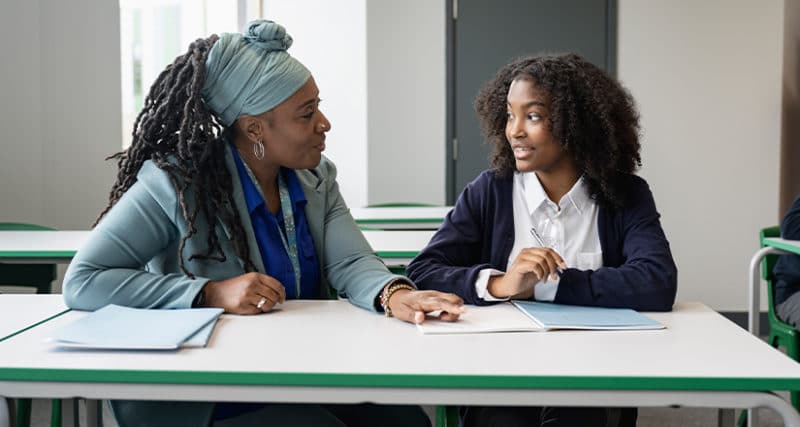Connect and Grow by Rediscovering Learning Conferences
Recently something happened to me that doesn’t happen very often. At least, it doesn’t happen often any more, now that I’m twenty years into this thing we call teaching. I sat in a district-mandated professional development session and was completely engaged and challenged for the entire 90-minute session. I know…I was surprised too.
In fact, my colleague and collaborative teacher (another veteran) and I both walked away from the PD session excited to keep talking about the topic presented and figuring out how best to make it work in our classes.
And what was most surprising was the topic of the session wasn’t something new; it wasn’t a cool, flashy tech tool. In fact, it was something that has been around since teaching has existed, but I had never seen it used the way the presenter utilized it in her classroom. The topic was one-on-one learning conferences.
As an ELA teacher, I have used one-on-one writing conferences for years to give my middle and high school students focused feedback on their writing. However, the presenter of the PD session, former teacher turned author and educational consultant Starr Sackstein, was talking about using learning conferences for a larger purpose: she was using them to help her high school students set learning goals and, ultimately, determine their grades in her class. She showed us real video (shot on her cell phone) of learning conferences she had with students at strategic points in the year. Listening to her students express where they had grown in their learning and defend what their grade should be in the class made me realize I was only scratching the surface of the power of conferences in my classroom.
So today, I want to do a deep dive into this old yet powerful strategy and consider the ways it can be used, look at the benefits for teachers and students, and address the real challenges to making it work in the classroom.
Types of Conferences
To begin, it’s important to first understand the various types of learning conferences, which are determined by the purpose at the heart of the conference. As I stated previously, I was using writing conferences to give focused feedback to students, and I’m not alone because the feedback conference is the most common type of learning conference used by teachers at all grade levels.
As the purpose of a conference grows broader to helping students reflect on their learning and set goals, it becomes a reflection conference. Starr Sackstein’s conferences, where students were in deep conversation about their progress toward standards, their level of mastery, and, ultimately, what their grades should be is a mastery conference. Educator and author John Spencer neatly broke down these three types of conferences in the chart below. Image credit
Image credit
If you are new to learning conferences, it’s best to start simply with short feedback conferences relating to a specific assessment, project or set of skills. As you figure out a conferencing process that works for you, you can slowly start to incorporate reflection or mastery conferences into your classroom, depending on the specific standards and grading policies in your school.
Benefits of Learning Conferences
No matter which type of learning conference you use in your classroom, the benefits are abundant and well documented. First, conferences empower students to have a say in their own learning. In his 2012 book Visible Learning for Teachers, researcher John Hattie synthesized the results of multiple studies from around the world and found that teachers talk at students 70-80% of class time. Conferences are a rare time when teachers can ask key questions and listen to individual students rather than doing the talking. If conferences are paired with students building a portfolio of their work, then students can track their growth from conference to conference and reference their work as evidence of their growth.
Speaking of growth, by talking through their learning process and products, conferences can help students connect how various steps they’ve taken or methods they’ve used have or have not worked well. That reflection, paired with specific feedback and positive encouragement from the teacher, can help students build confidence and adopt a growth mindset when setting learning goals for the future.
Finally, and most importantly, conferences can help build connection and deeper relationships. As teacher Ileana Sherry wrote in her recent Edutopia article about one-on-one conferences, they “[allow] me to talk with all of my students, see their faces, and hear their concerns.” As teachers, we know students are more engaged in classes where they have a rapport with their teacher and feel safe in the learning space. Both rapport and feelings of safety and community can be established by sitting down individually with students, listening to them, and giving them a say in their learning.
Challenges to Learning Conferences
I know what some of you are thinking: learning conferences sound great, but I just don’t have time! Considering many secondary teachers have upwards of 150 students, time is a significant challenge concerning our most precious commodity. Also, what do you do with the other 25+ students in the class while you are meeting with 1 student?
Addressing these challenges comes down to careful planning and preparation. The reality is conferences must be kept short, often 5 minutes or less. John Spencer and Ileana Sherry (both previously mentioned), offer the following practical tips for teachers:
- Discuss with students the structure and purpose of the conference ahead of time. You can even model a conference in front of the class with a willing student. Also, if possible, have students answer some reflective questions or gather evidence of their learning (maybe in a learning portfolio) ahead of time. That way you can get right down to business during conference time. In his article on conferencing, John Spencer offers a free guide to 5-minute conferences that includes questions to ask pre and during conferencing.
- Create a clear, consistent space for conferences to happen in your classroom so students always know where to go.
- Create a schedule and allow students to sign up ahead of time so they know when their conference will be.
- Plan projects or other learning activities that students can be working on individually while conferences are happening.
From personal experience, I have also learned to spread conferences out over a few days and only try to tackle a handful at a time. Finally, if possible, work with a colleague to back each other up during conference time. A former colleague and I would go into each other’s classes during our prep time to be an extra set of eyes and ears on conference days. This also showed our students we cared so much about conferencing with them that we would give up prep hours to make it happen. It was always a good investment of our time.
I hope that this has motivated you to rethink one-on-one conferencing in your classroom. Don’t be discouraged if conferences don’t go off without a hitch the first time through (or the first few times). Just keep refining your process as you go, and don’t be afraid to ask your students for feedback on how they would do things differently. I’ve found by giving them voice in conferencing, it only increases their buy-in and participation.
– Megan Panek






Comments are closed.